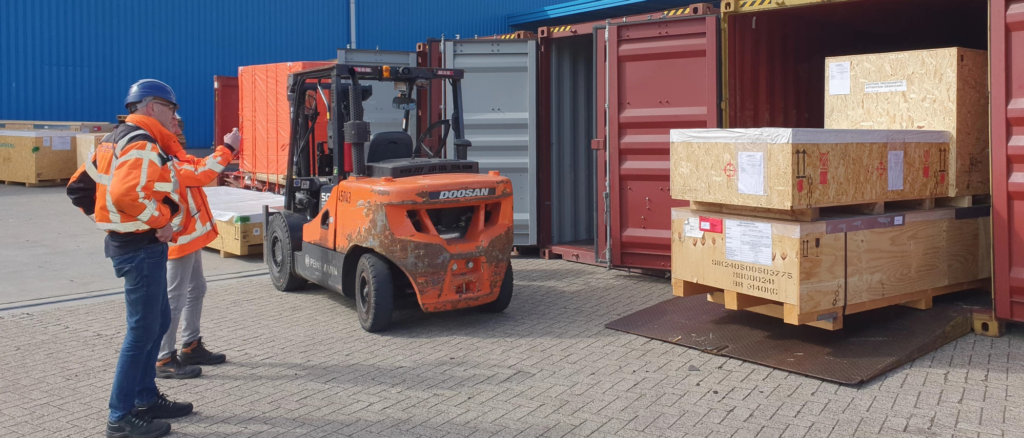
International maritime transport accounts for more than 80% of the world’s transport. Due to its low cost, and the possibility of moving loads with a high volume, sea transportation plays an important role in international trade. It is highly popular among businessmen. But sea transportation has different conditions and forms that change according to the type of cargo and other factors. cross-stuffing is one of the container transportation methods. It includes an important part of the world’s cargo traffic. In this article, we will explain the process, the reason for using and the cost of cross-stuffing.
Cross-stuffing method is one of the most widely sea transportation methods. This method is when there is no direct transportation line from the source to the destination. Sometimes seller insists on delivering the goods in a country other than the country of origin. In this case, the cargo transports by two different shipping lines from the origin to a third country and from there to the final destination. In fact, there is a need to change the shipping line in the third country. The cargo must unloaded from the container of the first line and loaded into the container of the second line, which is cross-stuffing operation. Of course, due to the processes, the cost of cross-stuffing is generally higher than other methods, but in some cases we will have to use it.

The use of special devices for unloading and loading in cross-staff operations. Cargo security is very important, because serious damage may cause to the cargo during the unloading and reloading process. For this reason, ensuring the presence of skilled and experienced operators can guarantee the safety of your load.
The use of cross-stuffing has its own reasons, some of these reasons are as follows:
When there is no direct route between origin and destination, different ships must take different routes to reach the destination. In this situation, this operation is to transfer cargo between ships.
Due to economic and political sanctions, the export and import of goods limits in some countries. In international sea transportation, if a country is to send cargo to the intended destination, it cannot send its cargo directly. It must use the cross-stuff method. In addition, if the shipping of a certain country is under sanctions, the ports of various regions do not allow the entry of these ships.
As you know, our country has been sanctioned by many countries in the world, especially European and American countries, in the last two decades. For example, if a product wants exchanging between the Netherlands and Iran, it is not possible to enter or export it directly between these two countries. A third sea line must be there as an intermediary between them in order to provide the possibility of trade. This change of shipping line is an effective factor on the cost of cross-stuffing.
Another application of cross-stuffing is to solve the problem of limited or crowded ports. If the volume of the ship carrying the cargo is large or the capacity of the destination port for berthing the ship is full, the containers are transferring to smaller ships with smaller dimensions in a place outside the port and the intended destination. By these ships, the cargo is delivered to the port. When the capacity of the destination port to berth the cargo ship is full, the only way to transfer the cargo to the desired country is to use the cross-stuff method.
In the mechanism of international sea transport, each method has its advantages and disadvantages, some of the advantages of using the cross-staff method for international transport are:
Disadvantages of cross-stuffing include the following:
cross-stuffing is a flexible method. It can solve a wide range of problems in maritime transport. As we said, it is to import and export goods that cannot directly import or export due to sanctions or other political and economic restrictions. Maybe you have interest in importing embargoed goods to Iran. Maybe you have a target market to earn income from these goods. If you are a producer of popular goods in European countries, this method is profitable enough for you to compensate for the high cost of cross-stuffing.

cross-stuffing is one of the most popular methods of sea transportation. You can have many advantages for both the sender and the receiver. In general, cross-stuffing means moving cargo from origin to destination. One stopover and in such a way that the cargo moves from the origin and stops at a third destination on the way. In this article, we tried to explain the concept of cross-stuffing, its advantages, disadvantages. Its role in international sea transportation. If you need cross-stuffing to transport your cargo, we will provide you with the best service.
Navban Darya Lian Company is a experts company in the field of logistics. It has many experiences in the field of cooperation with exporters and importers. The customer can count on the support and advice of the navigator in all stages of this international transportation. The necessary preparations to transport his goods and be sure of the safe arrival of his cargo at the destination.